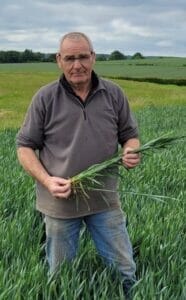
The biscuit wheat LG Astronomer was the best performing of five Group 3 varieties grown at the 1,200 ha Moundsmere Farming Company near Basingstoke this year, giving farmer Robert Brine good reason to sow it again this autumn.
Some 40 ha of LG Astronomer was tried for the first time in 2021/22, as a first wheat after winter beans, as he sought to restore his faith in Group 3 varieties.
Overall, Mr Brine was pleased with how the variety performed, in what was a challenging season, characterised by a lack of rainfall throughout spring and summer, and an exceptionally early harvest.
“We started combining around a fortnight earlier than normal and didn’t stop. This year we finished wheat before we even started it last season.”
Most of his LG Astronomer was cut around the end of the second week in August, with crops on the heavier clay cap ground yielding in excess of 12 t/ha, with specific weight coming in at 78-79 kg/hl. “It stood and thrashed well, as did most varieties this season.”
Given the lack of rainfall throughout much of the growing season, Mr Brine was happy that crops on thin, chalky soils still managed a respectable yield, typically averaging 8-8.5 t/ha, giving an overall average for the variety across all fields of around 10 t/ha.

Rob Brine
“Although it didn’t quite match the yields of some of the barn-filling feed wheats, out of the five Group 3’s we grew this year, LG Astronomer did perform the best,” he says.
“In all, we had eight different wheat varieties in the ground, which was too many really, so we will be looking to thin them down a bit this coming season.”
Mr Brine says he has not yet finalised wheat variety choices for harvest 2023, but is confident LG Astronomer will be among them.
He plans to grow the variety as a first wheat, likely to be sown in early to mid-October, depending on conditions.
“We usually establish crops using a two-pass system, based on one pass with a Köckerling tined cultivator, before drilling with the Horsch Sprinter tine drill, which we used for the first time last season, and found it performed very well. We’re now looking at direct drilling some crops, but only when conditions allow.”
Last year’s LG Astronomer was sown on 9 October, at a seed rate of 325/m2. Crops established strongly and came through last winter looking very well, Mr Brine recalls.
Dry weather throughout April was a concern, but a timely application of digestate to replace the second main fertiliser dose in April provided a useful boost to spring growth and greening.
“The digestate really kicked crops into gear.”
The combination of a dry April and LG Astronomer’s strong Recommended List scores for Septoria (6.8 on the three-year rating) and rust (8 for yellow and brown rust), did allow a slight saving on fungicides this season, as no T0 was applied, he adds.
At T1, LG Astronomer received AscraXpro (bixafen, Fluopyram + prothioconazole), with Univoq (fenpicoxamid + prothioconazole) applied as the T2 flag leaf fungicide, while the T3 was based on tebuconazole and azoxystrobin.
Mr Brine notes that the resistance to Orange Wheat Blossom Midge (OWBM) in LG Astronomer and other LG varieties, is a particular benefit at Moundsmere, especially as the business moves away from using insecticides, and puts more focus on maximising the use of beneficial species.































